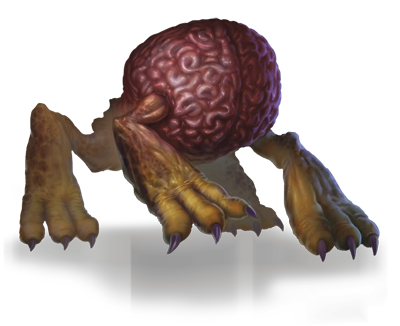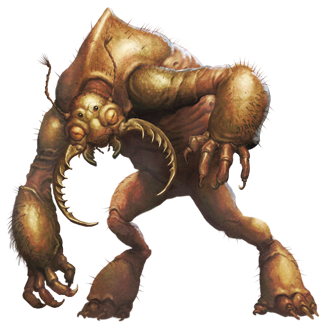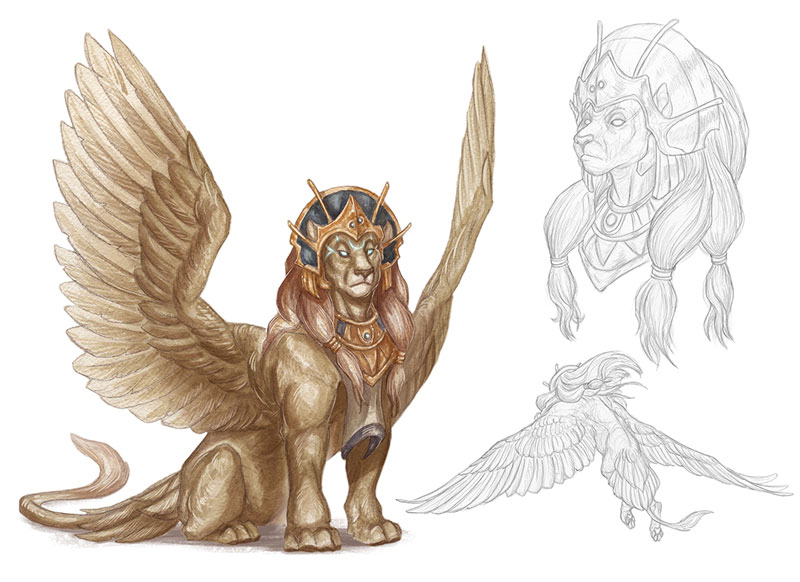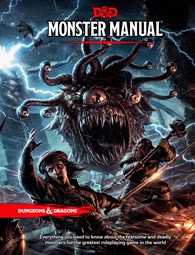Today was the early release date for the new Monster Manual
for the 5th edition of Dungeons & Dragons, available at Wizards Play Network stores. I picked one up, because I don’t mind paying full price for an early copy ($49.95 MSRP, $29.97 at Amazon, available in a couple of weeks).
Physically, it’s a nice looking book, 352 pages (compare with 316 pages for the Player’s Handbook). It’s got the same glossy cover and half-glossy back (which is a little annoying because every time I pick it up I have to check to make sure I haven’t grabbed a piece of paper beneath it by accident). It has a couple of obligatory “what is a monster” and “how to use this book” pages to explain the various monster entries, and then off we go with the aarakocra. There is ample artwork throughout (no boobs, even on the succubus and marilith), and I suppose it makes up for the lack of a text description of each creature.
 |
| Intellect Devourer |
Most of the monsters I would expect to see in such a book are present. We have beholders, goblins, giants, devils, demons, and of course dragons. Some entries are new (to me, at least); half-dragons, flameskulls, helmed horrors, and chuuls, for instance. Some I feel are missing that should have been included in a starting book of monsters; dryads, for instance, and most of the “faerie” type creatures. Plus derro. I love derro. While they do have some of the “made for the game” monsters like rust monsters, ear seekers, bookworms, and mimics, others such as the trapper are missing. I know such creatures aren’t popular with today’s crop of players, but as an old schooler I feel their absence.
Some oldies-but-goodies have been renamed. Ogre magi are now oni, which I suppose makes sense, but the rename seems somewhat arbitrary, although it does keep them right after “ogre” alphabetically. Merrow, on the other hand, have been completely changed from aquatic ogres to a corrupted form of merman. Fine. Daemons from 1st edition remain Yuggoloths, but they will always be Daemons in my game. Interestingly, although there is mention of demon lords and archdevils, there is no mention of the daemon lords or the Oinodaemon, just someone called The General. Anthraxus will, needless to say, exist in my game.
 |
| Umber Hulk |
Some creatures have had minor tweaks. Piercers are now larval forms of ropers, but at least those lovely “hidden death from above” beasties can still plague my large cavern spaces. Succubi/incubi are now no longer classified as demons, but are common to all the lower planes. I’m not sure how I like that; there was a certain symmetry in the succubus/erinyes dichotomy, but time will tell if I just end up ignoring it and calling them demons.
There’s lots of background text, which is both a boon and a bane. It certainly will help DMs who need some help integrating a creature into a game, but in some cases it becomes intrusive, such as the entry for shadow dragons, which is replete with references to “the Shadowfell” whatever that is. Perhaps it’s something that will get explained when the Dungeon Master’s Guide
comes out. They’ll be native to the Plane of Shadow in my campaign, where the Material casts its shadow from the light of the Positive.
I know a lot of people are bemoaning the lack of a table showing each monster by it’s challenge level, as they feel it would be very helpful for writing encounters. Apparently that (as well as encounters by terrain type) is coming in the DMG, just like it was in 1st edition.
 |
| Gynosphinx |
One oddity; there is a section at the back for “miscellaneous creatures.” These are much shorter than the full-page-at-least entries for the other creatures, and include both ordinary things like brown bears and mastiffs, as well as more esoteric creatures as blink dogs and giant fire beetles. They’re organized alphabetically, but whenever there’s a “giant” creature, they’re in the G’s, which I find confusing. I think, though, that the reason these miscellaneous creatures got stuck in the back is that it would have wreaked havoc with the pagination and layout of the creatures in the main part of the book.
Bottom line, this is a great monster book, and I think it’s worth the money. You could use a lot of the background text for any game, and the selection of creatures, while not perfect (in my completely subjective opinion), is certainly defensible for a “baseline” monster book that doesn’t strive to be completely comprehensive (although there is certainly room for such a thing, ahem).
This is certainly a worthy addition to the Player’s Handbook, and 5th edition is certainly shaping up to be something I’ll really enjoy playing and running. Next stop, the Dungeon Master’s Guide!










Nice review, thanks. I got my MM yesterday, and had previously found this which helps take the place of the missing 'official' CL list – http://www.theilluminerdy.com/2014/09/18/5e-monster-manual-monsters-by-challenge-rating/
http://media.wizards.com/2014/downloads/dnd/MM_MonstersCR.pdf
there is the Monster by CR list
If it helps, the Shadowfell is more or less a blending of the Plane of Shadow and the Negative Material.
In 4e (hiss boo) they reworked all the lore for the inner planes. I think the idea was to counter an observed tendency for players to treat them as big featureless Platonic expanses as opposed to worlds with interesting things in them. The Plane of Shadow got renamed the Shadowfell, the elemental planes got all jumbled up into an "Elemental Chaos", and I think the Positive Material got worked into the Feywild.
Encouraging people to put more cool shit on the Inner Planes wasn't a terrible idea, to be honest, but I do think the new names read like something out of "edgy" fanfiction by a particularly dull teenager.
Well, out of all the things out of 4e, there are only a very few that I actually liked.
One was the idea of the Shadowfell and the Feywilde. One was kind of a dark and shadowy reflection of the Prime, the other a more . . . primal? . . . reflection. They both were interesting ideas for an alternate style planar cosmology. The rest of it I could have done completely without, though.
The other thing, was an infamous combat overheard from another table in the game store: "everything's lighter in water, right?" And a four hour combat with a brown bear.
The Thing about Erinyes and Succubi is that Erinyes are not supposed to be pretty tempters like Succubi are. They are meant to be beautiful. wrathful, punishing warriors like the Erinyes of mythology.
On the Shadowfell it is pretty much a rename of the plane of shadows. You can get an idea of what it is if you look at the planes of the multiverse in the Players handbook
The General of Gehenna has been the leader of the Yugoloths/Daemons since 2e. The Oinoloth/Oinodaemon is stated to be below him in rank. Though it pretty much works like this. The General is the leader of the Daemons in Gehenna while the Oinodaemon is the leader of the Daemons in the Gray Wastes